Adaptive Intrawell Matched Stochastic Resonance with a Potential Constraint Aided Line Enhancer for Passive Sonars
Abstract
1. Introduction
2. Signal Model and Measurement
3. Adaptive Intrawell Matched Stochastic Resonance
3.1. Generalized Matched Stochastic Resonance with Duffing Oscillator
3.2. Framework of Intrawell Matched Stochastic Resonance with Potential Constraint
3.3. Adaptive Strategy for Optimized Implementation
3.4. Implementation of Adaptive Intrawell Matched Stochastic Resonance
| Algorithm 1Parameter Optimization Algorithm. |
| Parameter Initialization: |
| : the searching intervals; |
| : number of chromosome; |
| : Number of individuals in the population; |
| : The fraction to be replaced by crossover in each iteration; |
| : The mutation rate; |
| : The maximal iteration times; |
| : The threshold of stop condition. |
| Initialize generation 0: |
| k:=0; |
| :=a population of randomly-generated individuals; |
| Evaluate : |
| Compute fitness criteria SNRI for each ; |
| { |
| 1: Compute the corresponded MSR output by fourth order Runge–Kutta (RK4) method according to Equation (6) and obtain , where N is the length of the time series; |
| 2: Compute the SNRI according to Equation (14) and Equation (15); |
| } Create generation k+1: |
| do |
| { |
| 1: Copy: Select members of and insert into ; |
| 2: Crossover: Select members, pair them up to produce offspring and insert the offspring into ; |
| 3: Mutate: Select members of , and invert a randomly selected bit; |
| 4: Evaluate ; |
| 5: if then break; |
| 6: else |
| 7: Increment: k:=k+1; |
| 8: end if |
| } |
| while ; |
| return the optimal fittest individual from ; |
4. Filtering Performance Analysis and Evaluation
4.1. Discrete Line Signature Signal Analysis
4.2. Harmonic Related Line Signature Signal Analysis
5. Application Verification and Discussion
5.1. Verfication on AUV’s Low Frequency Propeller Harmonic Tonals
5.2. Discussion
6. Conclusions
Author Contributions
Funding
Conflicts of Interest
References
- Carter, G.C. Passive sonar signal processing. In Underwater Acoustics and Signal Processing; Springer: Berlin, Germany, 1981; pp. 499–508. [Google Scholar]
- Zimmerman, R.; D’Spain, G.; Chadwell, C.D. Decreasing the radiated acoustic and vibration noise of a mid-size AUV. IEEE J. Ocean. Eng. 2005, 30, 179–187. [Google Scholar] [CrossRef]
- Etter, P.C. Advanced applications for underwater acoustic modeling. Adv. Acoust. Vib. 2012, 2012. [Google Scholar] [CrossRef]
- Ross, D. Mechanics of Underwater Noise; Pergamon Press: Los Altos, CA, USA, 1976. [Google Scholar]
- Urick, R.J. Principles of Underwater Sound; McGraw-Hill: New York, NY, USA, 1983. [Google Scholar]
- Waite, A.D.; Waite, A. Sonar for Practising Engineers; Wiley: New York, NY, USA, 2002; Volume 3. [Google Scholar]
- Antoni, J.; Hanson, D. Detection of surface ships from interception of cyclostationary signature with the cyclic modulation coherence. IEEE J. Ocean. Eng. 2012, 37, 478–493. [Google Scholar] [CrossRef]
- Dong, H.; Wang, H.; Shen, X.; He, K. Parameter matched stochastic resonance with damping for passive sonar detection. J. Sound Vib. 2019, 458, 479–496. [Google Scholar] [CrossRef]
- Hollmann, L.J.; Stevenson, R.L. Adaptive whitening of ambient ocean noise with narrowband signal preservation. J. Acoust. Soc. Am. 2016, 139, 3122–3133. [Google Scholar] [CrossRef]
- Guo, Y.; Zhao, J.; Chen, H. A novel algorithm for underwater moving-target dynamic line enhancement. Appl. Acoust. 2003, 64, 1159–1169. [Google Scholar] [CrossRef]
- Bershad, N.J.; Eweda, E.; Bermudez, J.C. Stochastic analysis of an adaptive line enhancer/canceler with a cyclostationary input. IEEE Trans. Signal Process. 2015, 64, 104–119. [Google Scholar] [CrossRef]
- Hao, Y.; Chi, C.; Qiu, L.; Liang, G. Sparsity-based adaptive line enhancer for passive sonars. IET Radar Sonar Navig. 2019, 13, 1796–1804. [Google Scholar] [CrossRef]
- Kay, S. Can detectability be improved by adding noise? IEEE Signal Process. Lett. 2000, 7, 8–10. [Google Scholar] [CrossRef]
- Gammaitoni, L.; Hänggi, P.; Jung, P.; Marchesoni, F. Stochastic resonance. Rev. Mod. Phys. 1998, 70, 223–286. [Google Scholar] [CrossRef]
- Benzi, R.; Sutera, A.; Vulpiani, A. The mechanism of stochastic resonance. J. Phys. A Math. Gen. 1981, 14, L453. [Google Scholar] [CrossRef]
- Harmer, G.P.; Davis, B.R.; Abbott, D. A review of stochastic resonance: Circuits and measurement. IEEE Trans. Instrum. Meas. 2002, 51, 299–309. [Google Scholar] [CrossRef]
- Moss, F.; Ward, L.M.; Sannita, W.G. Stochastic resonance and sensory information processing: A tutorial and review of application. Clin. Neurophysiol. 2004, 115, 267–281. [Google Scholar] [CrossRef]
- McDonnell, M.D.; Abbott, D. What is stochastic resonance? Definitions, misconceptions, debates, and its relevance to biology. PLoS Comput. Biol. 2009, 5, e1000348. [Google Scholar] [CrossRef]
- Dylov, D.V.; Fleischer, J.W. Nonlinear self-filtering of noisy images via dynamical stochastic resonance. Nat. Photonics 2010, 4, 323–328. [Google Scholar] [CrossRef]
- Lu, S.; He, Q.; Wang, J. A review of stochastic resonance in rotating machine fault detection. Mech. Syst. Signal Process. 2019, 116, 230–260. [Google Scholar] [CrossRef]
- Qiao, Z.; Lei, Y.; Li, N. Applications of stochastic resonance to machinery fault detection: A review and tutorial. Mech. Syst. Signal Process. 2019, 122, 502–536. [Google Scholar] [CrossRef]
- Xu, B.; Duan, F.; Bao, R.; Li, J. Stochastic resonance with tuning system parameters: The application of bistable systems in signal processing. Chaos Solitons Fractals 2002, 13, 633–644. [Google Scholar] [CrossRef]
- Lu, S.; He, Q.; Kong, F. Effects of underdamped step-varying second-order stochastic resonance for weak signal detection. Digit. Signal Process. 2015, 36, 93–103. [Google Scholar] [CrossRef]
- Dong, H.; Wang, H.; Shen, X.; Jiang, Z. Effects of Second-Order Matched Stochastic Resonance for Weak Signal Detection. IEEE Access 2018, 6, 46505–46515. [Google Scholar] [CrossRef]
- Lu, S.; He, Q.; Yuan, T.; Kong, F. Online fault diagnosis of motor bearing via stochastic-resonance-based adaptive filter in an embedded system. IEEE Trans. Syst. Man Cybern. Syst. 2017, 47, 1111–1122. [Google Scholar] [CrossRef]
- Hu, N.Q. Theory and Methods for Weak Characteristic Signal Detection with Stochastic Resonance; National Defense Industry Press: Beijing, China, 2012. [Google Scholar]
- Leng, Y.G.; Wang, T.Y.; Guo, Y.; Xu, Y.G.; Fan, S.B. Engineering signal processing based on bistable stochastic resonance. Mech. Syst. Signal Process. 2007, 21, 138–150. [Google Scholar] [CrossRef]
- Rebolledo-Herrera, L.F.; FV, G.E. Quartic double-well system modulation for under-damped stochastic resonance tuning. Digit. Signal Process. 2016, 52, 55–63. [Google Scholar] [CrossRef]
- Li, J.; Zhang, Y.; Xie, P. A new adaptive cascaded stochastic resonance method for impact features extraction in gear fault diagnosis. Measurement 2016, 91, 499–508. [Google Scholar] [CrossRef]
- Shi, P.; An, S.; Li, P.; Han, D. Signal feature extraction based on cascaded multi-stable stochastic resonance denoising and EMD method. Measurement 2016, 90, 318–328. [Google Scholar] [CrossRef]
- Li, J.; Zhang, J.; Li, M.; Zhang, Y. A novel adaptive stochastic resonance method based on coupled bistable systems and its application in rolling bearing fault diagnosis. Mech. Syst. Signal Process. 2019, 114, 128–145. [Google Scholar] [CrossRef]
- Xiao, L.; Tang, J.; Zhang, X.; Xia, T. Weak fault detection in rotating machineries by using vibrational resonance and coupled varying-stable nonlinear systems. J. Sound Vib. 2020, 478, 115355. [Google Scholar] [CrossRef]
- Andò, B.; Graziani, S. Stochastic Resonance: Theory and Applications; Springer Science & Business Media: Berlin, Germany, 2012. [Google Scholar]
- Tan, J.; Chen, X.; Wang, J.; Chen, H.; Cao, H.; Zi, Y.; He, Z. Study of frequency-shifted and re-scaling stochastic resonance and its application to fault diagnosis. Mech. Syst. Signal Process. 2009, 23, 811–822. [Google Scholar] [CrossRef]
- Alfonsi, L.; Gammaitoni, L.; Santucci, S.; Bulsara, A. Intrawell stochastic resonance versus interwell stochastic resonance in underdamped bistable systems. Phys. Rev. E 2000, 62, 299. [Google Scholar] [CrossRef]
- Li, H.; Bao, R.; Xu, B.; Zheng, J. Intrawell stochastic resonance of bistable system. J. Sound Vib. 2004, 272, 155–167. [Google Scholar] [CrossRef]
- Dong, H.; Wang, H.; Shen, X.; Yong, X. Nonlinear filtering effects of intrawell matched stochastic resonance with barrier constrainted Duffing system for ship radiated line signature extraction. J. Sound Vib. 2020. submitted. [Google Scholar]
- Arveson, P.T.; Vendittis, D.J. Radiated noise characteristics of a modern cargo ship. J. Acoust. Soc. Am. 2000, 107, 118–129. [Google Scholar] [CrossRef] [PubMed]
- Ogden, G.L.; Zurk, L.M.; Jones, M.E.; Peterson, M.E. Extraction of small boat harmonic signatures from passive sonar. J. Acoust. Soc. Am. 2011, 129, 3768–3776. [Google Scholar] [CrossRef] [PubMed]
- Bao, F.; Wang, X.; Tao, Z.; Wang, Q.; Du, S. Adaptive extraction of modulation for cavitation noise. J. Acoust. Soc. Am. 2009, 126, 3106–3113. [Google Scholar] [CrossRef] [PubMed]
- Dong, H.; Wang, H.; Shen, X.; Ma, S. Adaptive Matched Stochastic Resonance Enhanced Speedboat Seismoacoustic Signature under Heavy Background noise. In Proceedings of the OCEANS’2018 MTS/IEEE Charleston, Charleston, SC, USA, 22–25 October 2018; IEEE: Piscataway, NJ, USA, 2018; pp. 1–5. [Google Scholar]
- Zhang, R.; Zhou, S.; Qi, Y.; Liang, Y.; Sui, Y. Characteristics of very-low-frequency pulse acoustic fields measured by vector sensor and ocean bottom seismometer in shallow water. J. Acoust. Soc. Am. 2018, 144, 1916. [Google Scholar] [CrossRef]
- Silvia, M.T.; Richards, R.T. A theoretical and experimental investigation of low-frequency acoustic vector sensors. In Proceedings of the OCEANS’02 MTS/IEEE, Biloxi, MI, USA, 29–31 October 2002; IEEE: Piscataway, NJ, USA, 2002; pp. 1886–1897. [Google Scholar]
- Lepper, P.A.; D’Spain, G.L. Measurement and modeling of the acoustic field near an underwater vehicle and implications for acoustic source localization. J. Acoust. Soc. Am. 2007, 122, 892–905. [Google Scholar] [CrossRef]
- Zozor, S.; Amblard, P.O. On the use of stochastic resonance in sine detection. Signal Process. 2002, 82, 353–367. [Google Scholar] [CrossRef]
- Medan, Y.; Yair, E.; Chazan, D. Super resolution pitch determination of speech signals. IEEE Trans. Signal Process. 1991, 39, 40–48. [Google Scholar] [CrossRef]
- Akay, M. Detection and Estimation Methods for Biomedical Signals; Academic Press: San Diego, CA, USA, 1996. [Google Scholar]
- Christensen, M.G.; Stoica, P.; Jakobsson, A.; Jensen, S.H. Multi-pitch estimation. Signal Process. 2008, 88, 972–983. [Google Scholar] [CrossRef]
- Lai, Z.H.; Leng, Y.G. Weak-signal detection based on the stochastic resonance of bistable Duffing oscillator and its application in incipient fault diagnosis. Mech. Syst. Signal Process. 2016, 81, 60–74. [Google Scholar] [CrossRef]
- Lu, S.; He, Q.; Kong, F. Stochastic resonance with Woods–Saxon potential for rolling element bearing fault diagnosis. Mech. Syst. Signal Process. 2014, 45, 488–503. [Google Scholar] [CrossRef]
- López, C.; Zhong, W.; Lu, S.; Cong, F.; Cortese, I. Stochastic resonance in an underdamped system with FitzHug-Nagumo potential for weak signal detection. J. Sound Vib. 2017, 411, 34–46. [Google Scholar] [CrossRef]
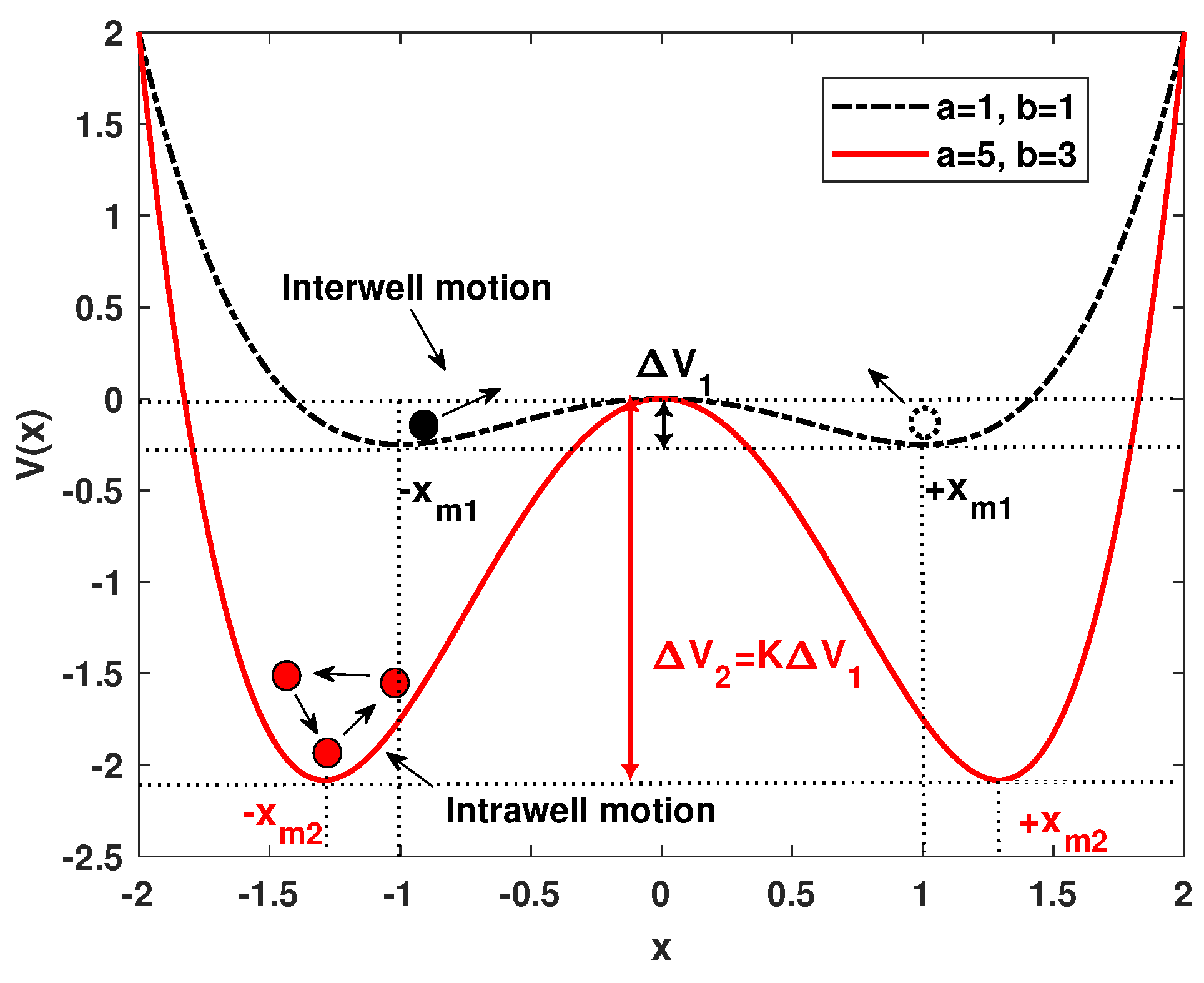
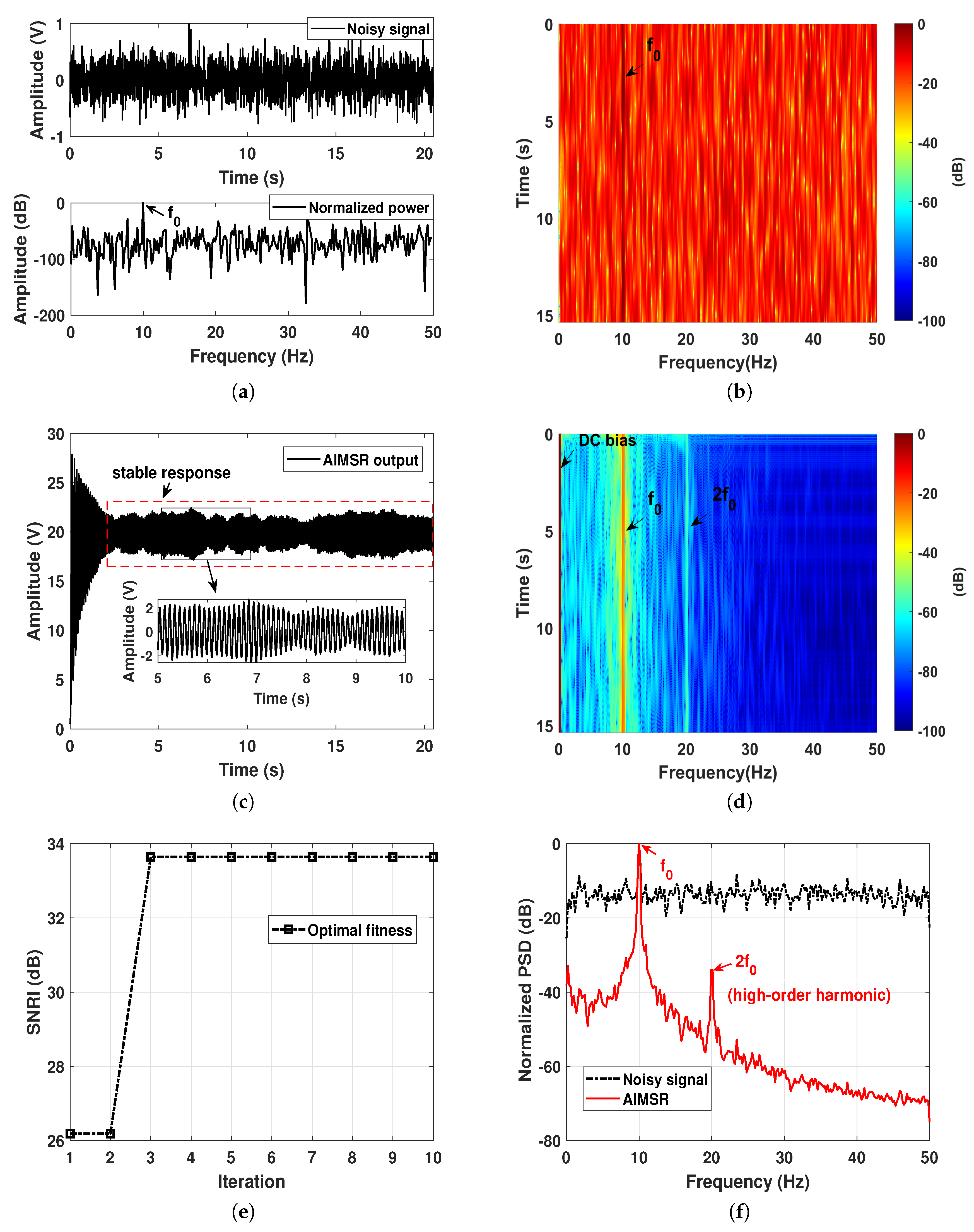



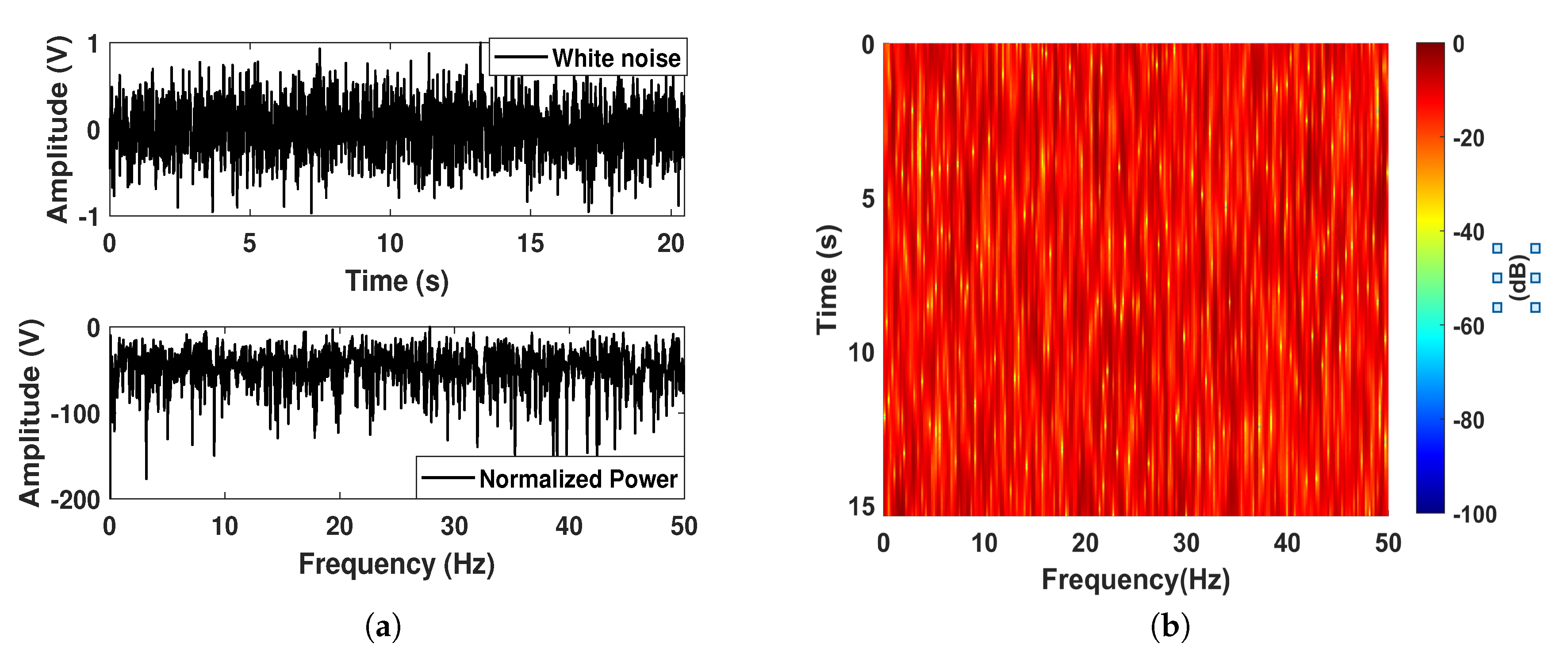
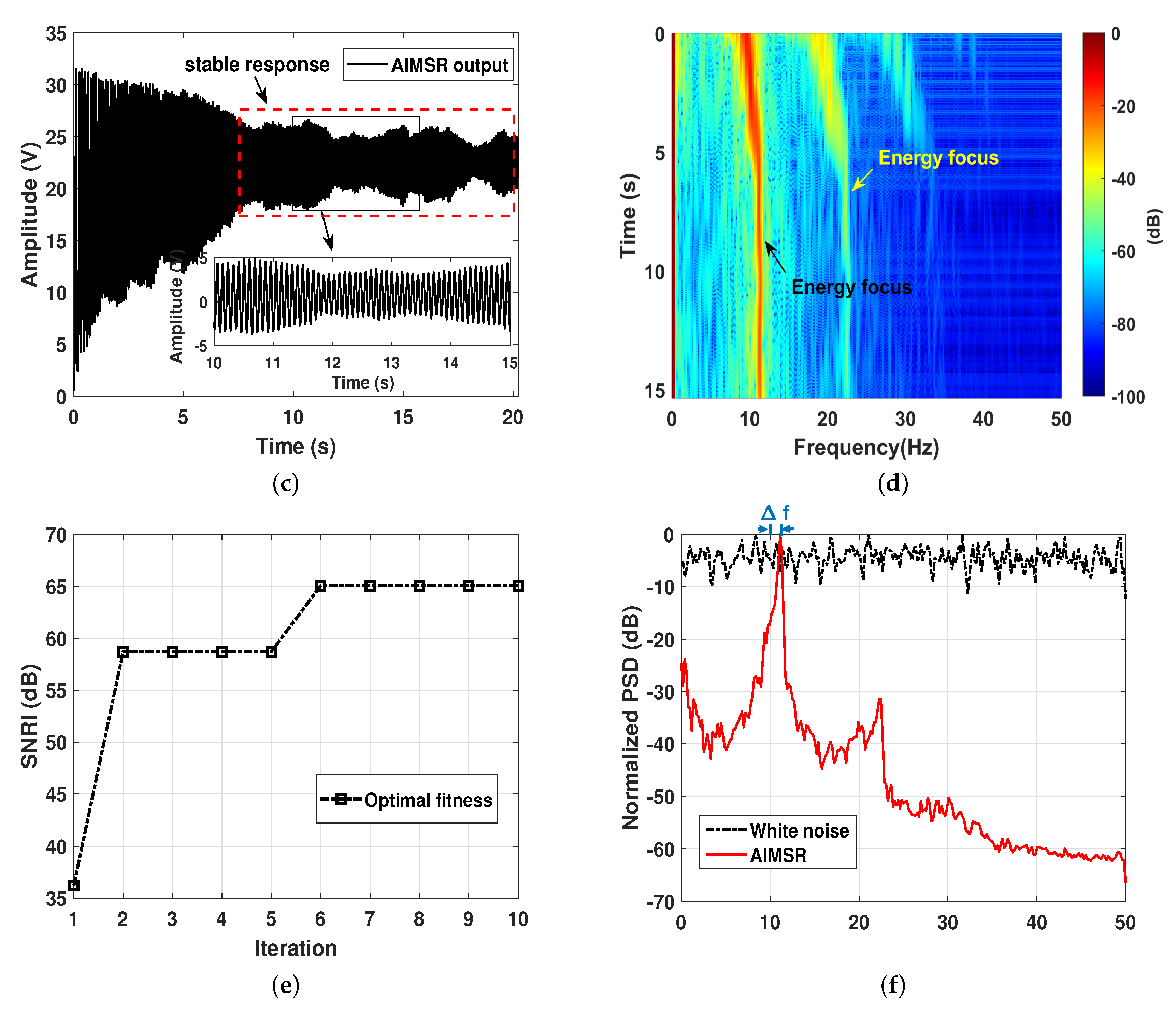
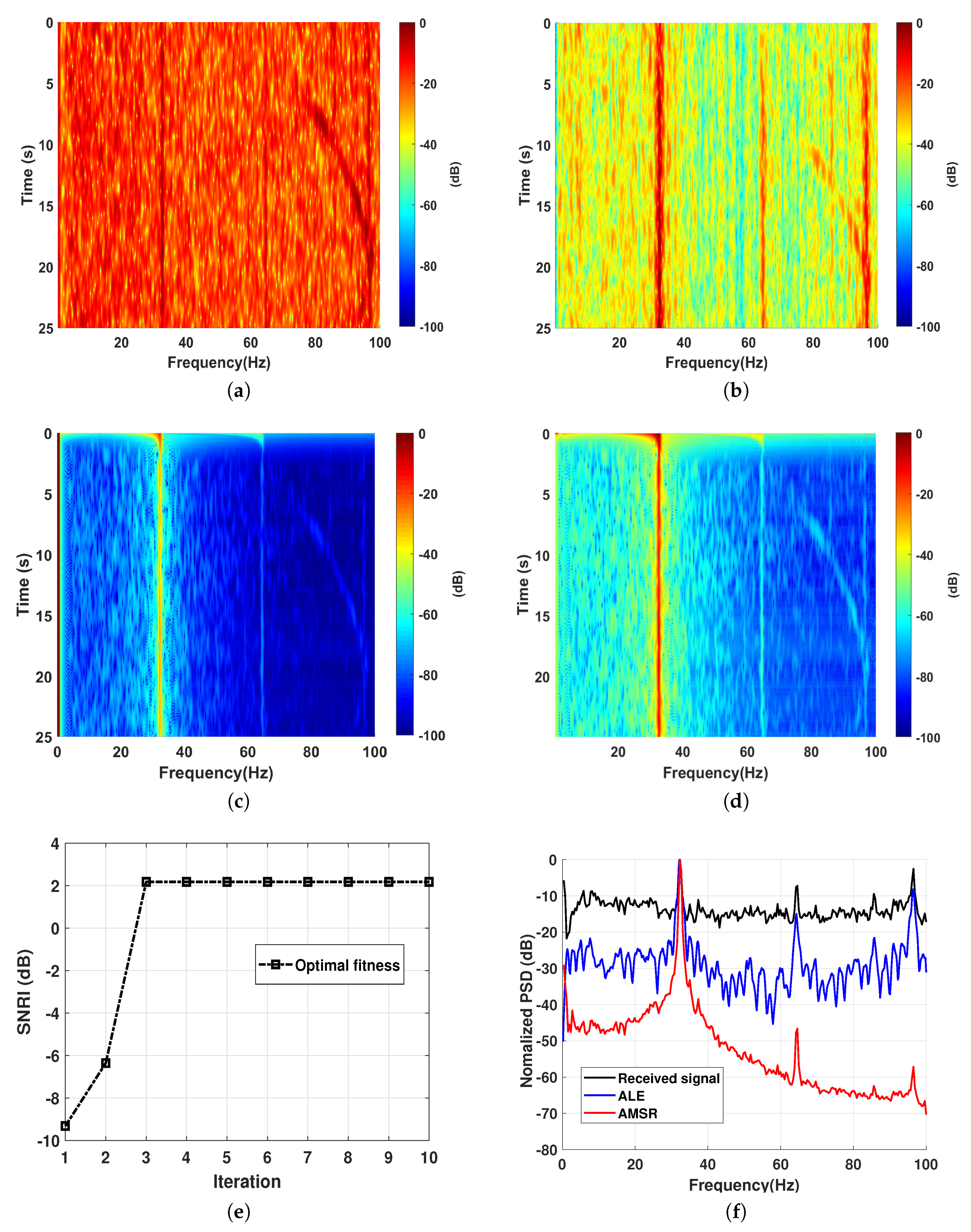
| Engine Rates | Propeller Rates |
|---|---|
| Cylinder Firing Rate | Shaft Rotation Rate : Gear Ratio |
| Crankshaft Rotation Rate RPM: Engine Speed | Blade Rotation Rate : Number of Blades |
| Engine Firing Rate : Number of Cylinders |
© 2020 by the authors. Licensee MDPI, Basel, Switzerland. This article is an open access article distributed under the terms and conditions of the Creative Commons Attribution (CC BY) license (http://creativecommons.org/licenses/by/4.0/).
Share and Cite
Dong, H.; He, K.; Shen, X.; Ma, S.; Wang, H.; Qiao, C. Adaptive Intrawell Matched Stochastic Resonance with a Potential Constraint Aided Line Enhancer for Passive Sonars. Sensors 2020, 20, 3269. https://doi.org/10.3390/s20113269
Dong H, He K, Shen X, Ma S, Wang H, Qiao C. Adaptive Intrawell Matched Stochastic Resonance with a Potential Constraint Aided Line Enhancer for Passive Sonars. Sensors. 2020; 20(11):3269. https://doi.org/10.3390/s20113269
Chicago/Turabian StyleDong, Haitao, Ke He, Xiaohong Shen, Shilei Ma, Haiyan Wang, and Changcheng Qiao. 2020. "Adaptive Intrawell Matched Stochastic Resonance with a Potential Constraint Aided Line Enhancer for Passive Sonars" Sensors 20, no. 11: 3269. https://doi.org/10.3390/s20113269
APA StyleDong, H., He, K., Shen, X., Ma, S., Wang, H., & Qiao, C. (2020). Adaptive Intrawell Matched Stochastic Resonance with a Potential Constraint Aided Line Enhancer for Passive Sonars. Sensors, 20(11), 3269. https://doi.org/10.3390/s20113269





